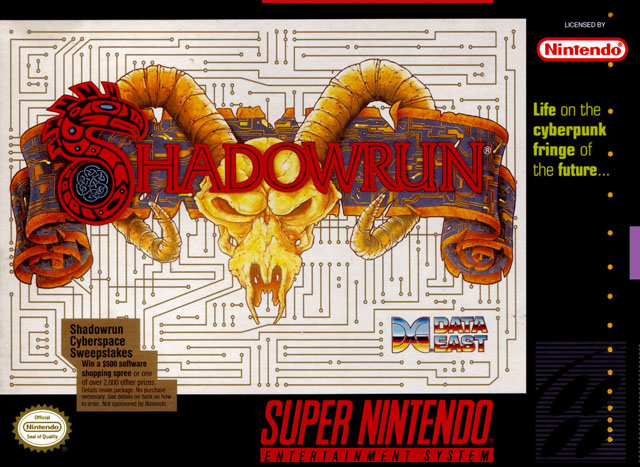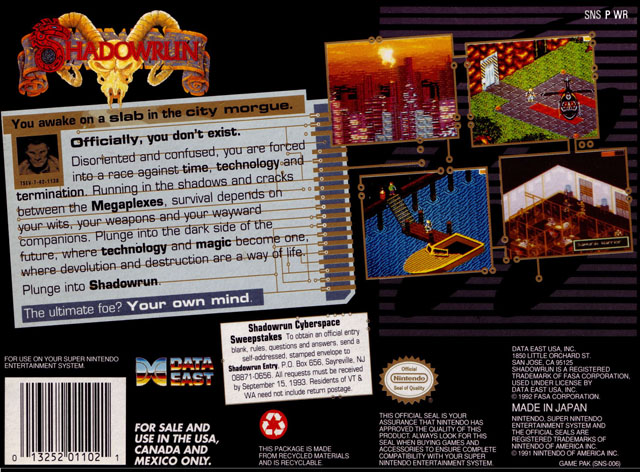
In 2007 FASA Interactive and Microsoft Game Studios gave us the absolute abortion of a video game known as Shadowrun.
This downright broken, multiplayer FPS very nearly suckered me in with its claims of a cyberpunk backdrop and promises of cross-platform play between its PC and Xbox 360 versions… and motherfucking hang-gliders. However, these meaty nuggets of cool couldn’t help but get slimed by the shit-gumbo that was the game’s atrocious matchmaking service (I’ve never waited longer to find a suitable match on any multiplayer game before or since) and the simply boring, broken gameplay.
However, 2007’s Shadowrun did serve to provide one glimmering ray of positivity in that it brought 1993’s Shadowrun (SNES) to my attention.
The Super Nintendo version of Shadowrun is, in fact, based on the book Never Deal with a Dragon which is, in turn, based on a tabletop RPG also called Shadowrun.
I was still a wee babe in 1993 and I had yet to develop full control of my thumbs, much less an appreciation for video games, so I should be forgiven for passing the game by when it first came out. Also, according to Wikipedia, the game sold like a radio-active 20-sided die so all the golden oldies can bite me; they never bought it either.
The universe of the franchise is set in a near future Earth where that blends cyberpunk sci-fi with basic orcs-and-elves fantasy tropes. Anyone that knows me at all could tell you that this is sounds like a concoction made to order specifically for me. As someone who counts Philip K. Dick and George R. R. Martin among his top five authors of all time, it was clear to me as I slapped the dust off of my SNES and popped in the cartridge that my sheer psychic glee was probably enough to give Miss Cleo a migraine.
The first thing that I noticed about Shadowrun even as the opening logo scrolled was that it is technically pretty ugly. Now, bear in mind that this is a game about an urban dystopia filled with magical mutants and pollution-loving mega-corporations. The Super Nintendo, while certainly a formidable piece of machinery at the time, wasn’t really equipped to handle such a serious world. That being said, the limited color palette and general muddiness presented in the visuals actually tends to lend to the aesthetic.
Artistic appreciation aside, 1993 was the year the year of Starfox, people. While there are quite a few people that argue the artistic merit of that particular game, 3D graphics on a 16 bit system was a bold move. Just don’t expect anything like Mode 7 or Super FX out of this particular title.
Something that holds up much better in this era is the music. In keeping with the grimy noire-ish feel of the universe, the music is dark, moody and freaking magnificent. The tunes do a perfect job of capturing the feel of a dark, rain-slick future full of cyborgs and assassins in leather coats as seen through the lens of the 80’s and 90’s. Much like many games from its era, Shadowrun relies less on its limited visuals and more on its striking, jazz-infused techno to create a climate of mystery, danger and sometimes outright uneasiness.

If you need a basis of comparison, try to think of a more down-to-earth Metroid soundtrack interlaced with street-performance blues as played through a rusty harmonica. Actually, you know what, just go Youtube the soundtrack. I’ll wait.
The music is so good in fact that, as I’m writing this article, I’m listening to the game’s main theme on a loop right now. I only wish that there was an OST floating around out there to complement the game in my collection.
The story, as I mentioned, is based on a novel. Now, I’ll be the first one to say that novelizations of table-top RPG’s aren’t usually Shakespeare but I’m not going to hold that against the game. R. A. Salvatore certainly seems to have been able to make it work so why the hell not?
Actually, I was quite impressed with the storyline for what it was. Science fiction written in the 80’s and 90’s that didn’t come in book form was always hit-or-miss with me at best. However, Shadowrun was not only drawing from a novel but from an entire pre-rendered universe designed specifically for people to play within. Lest we all forget Planescape: Torment which, for my money, is not only the best licensed video game of all time but also tells one of the best fantasy stories ever written period.
Shadowrun doesn’t quite reach the heights of Black Isle’s masterpiece but it does tell a pretty fun tale centered around shapeshifters, talking dogs and a virtual reality called The Matrix (this was well before the film). The plot’s main thread doesn’t hold up quite as well as the overall feel of the world but it really doesn’t have to. Exploring the game’s universe is intriguing enough to be its own reward and the main quest isn’t bad, it’s just not as compelling as the world itself.
One thing that really hurts the game’s narrative doesn’t come from the story at all but rather from Nintendo’s ever present desire to maintain its squeaky clean image. While Mortal Kombat may certainly be the most commonly cited example of censorship during this era in gaming, it was not the only one. Shadowrun’s dialogue is yet another unfortunate victim of Nintendo’s mouth-full-of-soap policy. Hearing characters use terms like “geeked” instead of “killed” just feels awkward in what you’d think would otherwise be a potty-mouthed environment.
All references to sexual themes, alcohol and even some of the more extreme instances of violence were altered or outright removed for the sake of Nintendo’s famous “Seal of Quality”. It really doesn’t do what is otherwise a very adult game justice.
Now, you might be thinking that all of these aesthetics and story components are all well and good, but how does the gameplay hold up after nearly 20 years off the shelf?
Well, this is where things get really weird. If I had to nail down a specific genre, I’d have to say that Shadowrun is a top-down action RPG with elements of a point-and-click adventure game.
The player collects experience, here called “karma”, for killing enemies in the game world. Experience accrues until you finally level up and are allowed to rest and spend a certain number of talent points (awarded for leveling) on increasing attributes that affect things like the character’s health, magic and overall damage. Basically, the role playing elements work out like the Elder Scrolls games except with murdering the many hitmen hidden on just about every screen being the only way to raise experience.
The point-and-click elements are about what you’d expect. With the press of a button, a cursor appears onscreen allowing you to pixel-hunt for clues, weapons, ammo, etc.
The combat works much the same way as the adventuring. Pressing a different button will bring up a different cursor that you scroll across screen. When the cursor is brought over an enemy, mashing on one of the face buttons will cause the protagonist to open fire with his equipped weapon.
Various spells are thrown into the mix just for good measure but the SNES wasn’t exactly designed to be used like a mouse and it’s easy to become frustrated squishing down the d-pad for so long to find a target.
Interestingly, the game seems to feature sticky targeting and a simple cover system. Bringing the cursor “close enough” to a target will lock it into position while standing behind junk scattered throughout the world will block enemy shots as well as interfere with your own aim. These may not seem exactly ground-breaking in this, the era of the first-person shooter, but I was incredibly surprised and even impressed to discover these elements in a game that came out before Donkey Kong County.
The most interesting aspect of the game comes in the form of interacting with NPC’s.
Conversing with different characters in the game will sometimes bring up key topics. These subjects are then added to a list of keywords that can be brought up to any NPC who will then either give you clues towards solving quests or introduce new topics for later use. Or they’ll tell you to go screw yourself. That can happen too.
It’s very neat to see such a cool idea implemented so early in gaming’s history; and on a console no less. While it’s not something that you see imitated all that often anymore, it is clear that it had some impact on Western RPGs such as Morrowind and the aforementioned Planescape: Torment. Pretty impressive for a game that hit store shelves a full year before the first Elder Scrolls game.
After playing through the game, I was truly disappointed to learn that it didn’t sell very well. It’s a game that really never got its time in the spotlight and, except for a few minor “best of” lists, is never really discussed with the same adoration as its RPG contemporaries. Furthermore, due to low shipping numbers at the time of its release, it can be difficult to find a copy, especially for a decent price (current amazon.com listings have new copies set to sell for 149.99).
If you can find a copy for a decent price I wholeheartedly recommend picking up Shadowrun. It’s a neat piece of 16-bit gaming history that feels far ahead of its time and holds up surprisingly well considering it’s unique style of play.
Shadowrun is definitely worth including in any retro gaming enthusiast’s collection.


3 Comments